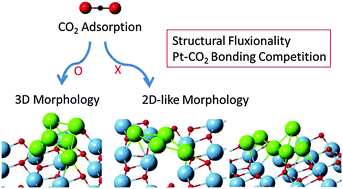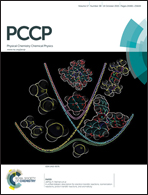The effect of the morphology of supported subnanometer Pt clusters on the first and key step of CO2 photoreduction†
Abstract
Using density functional theory calculations, we investigate the influence of size-dependent cluster morphology on the synergistic catalytic properties of anatase TiO2(101) surfaces decorated with subnanometer Pt clusters. Focusing on the formation of the key precursor in the CO2 photoreduction reaction (bent CO2−), we find that flatter (2D-like) Pt clusters that “wet” the TiO2 surface offer significantly less benefit than 3D-like Pt clusters. We attribute the differences to three factors. First, the 3D clusters provide a greater number of accessible Pt–TiO2 interfacial sites with geometries that can aid CO2 bond bending and charge transfer processes. Second, binding competition among each Pt–CO2 bonding interaction mitigates maximum orbital overlaps, leading to insufficient CO2 binding. Third and also most interestingly, the 3D clusters tend to possess higher structural fluxionality than the flatter clusters, which is shown to correlate positively with CO2 binding strength. The preferred morphology adopted by the clusters depends on several factors, including the cluster size and the presence of oxygen vacancies on the TiO2 surface; this suggests a strategy for optimizing the synergistic effect between Pt clusters and TiO2 surfaces for CO2 photocatalysis. Clusters of ∼6–8 atoms should provide the largest benefit, since they retain the desired 3D morphology, yet are small enough to exhibit high structural fluxionality. Electronic structure analysis provides additional insight into the electronic motivations for the enhanced binding of CO2 on TiO2-supported 3D Pt clusters, as well as suppressed binding on flattened, 2D-like clusters.


 Please wait while we load your content...
Please wait while we load your content...